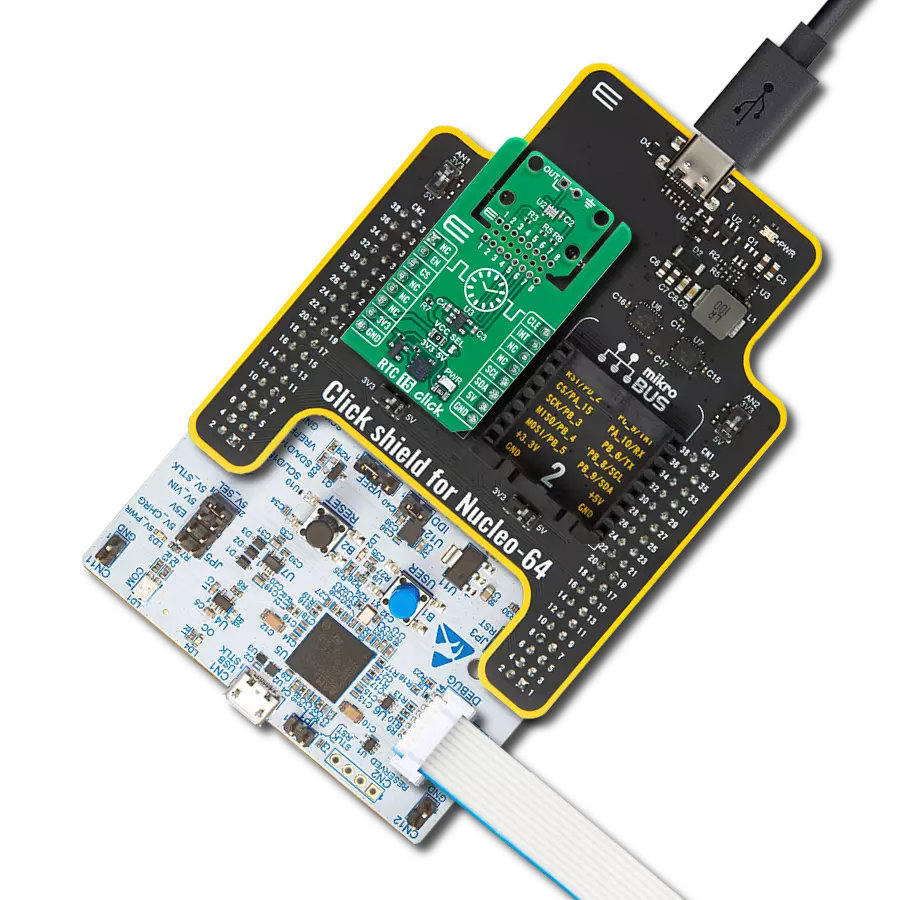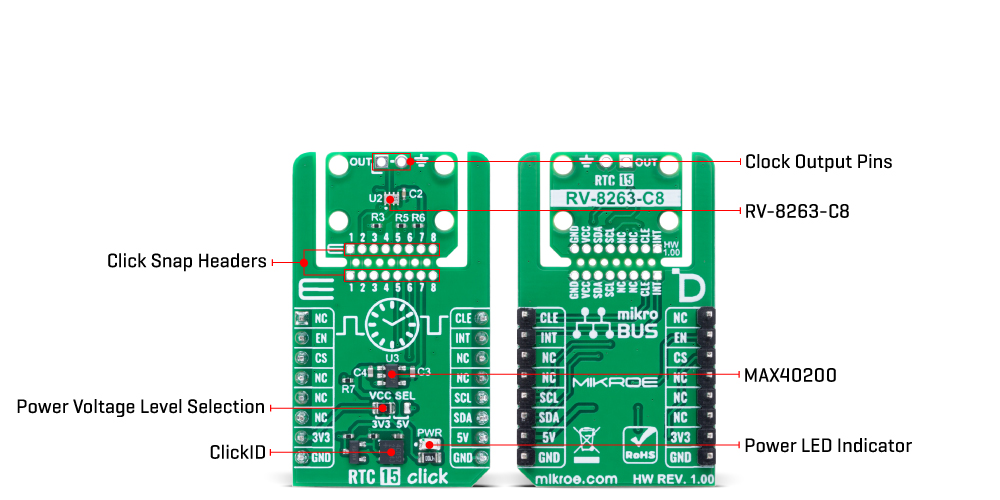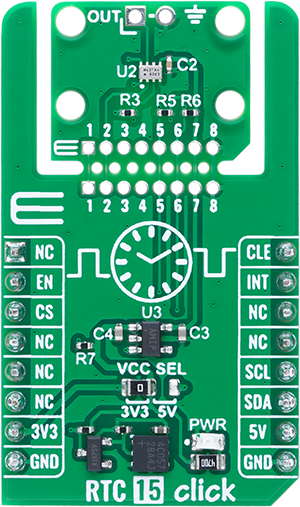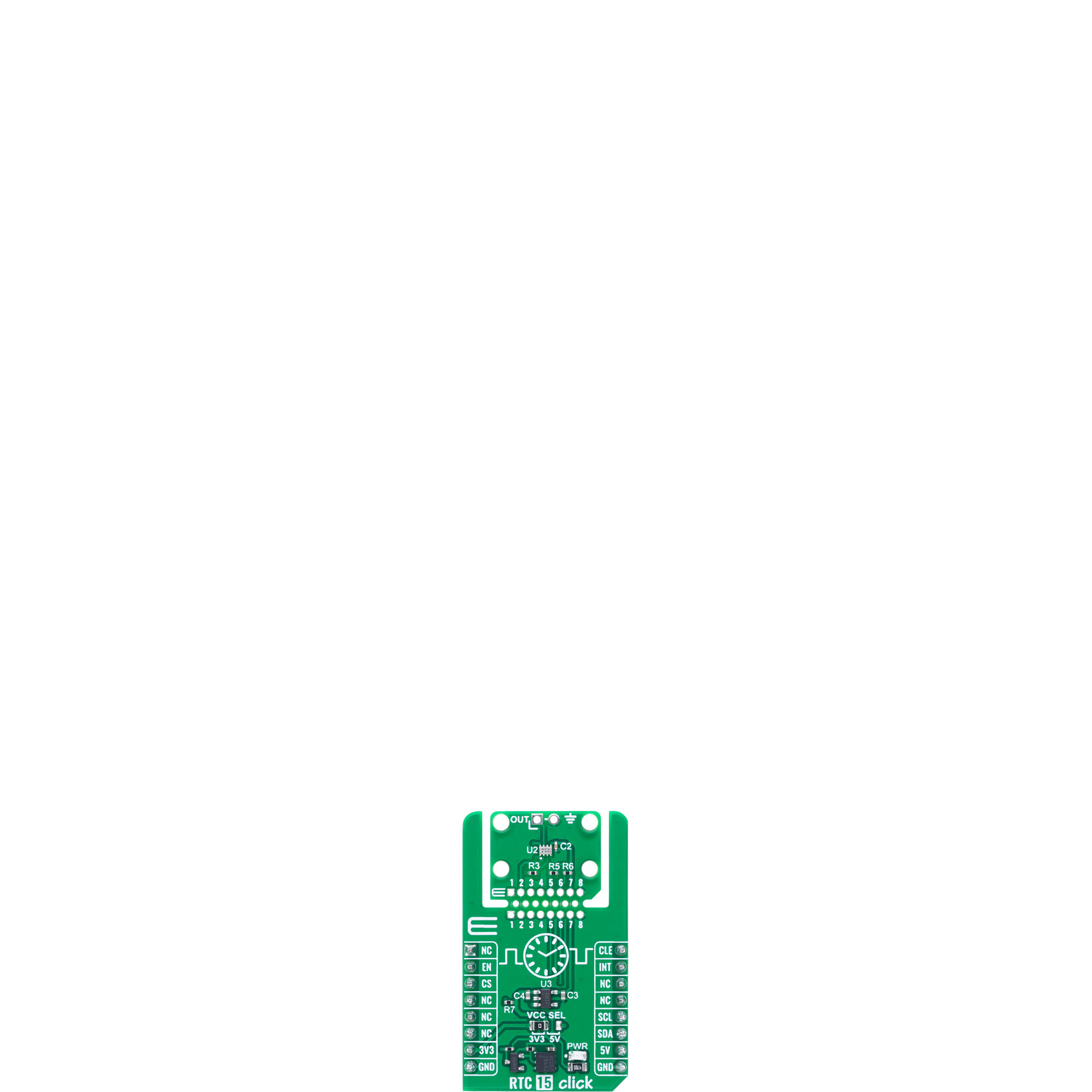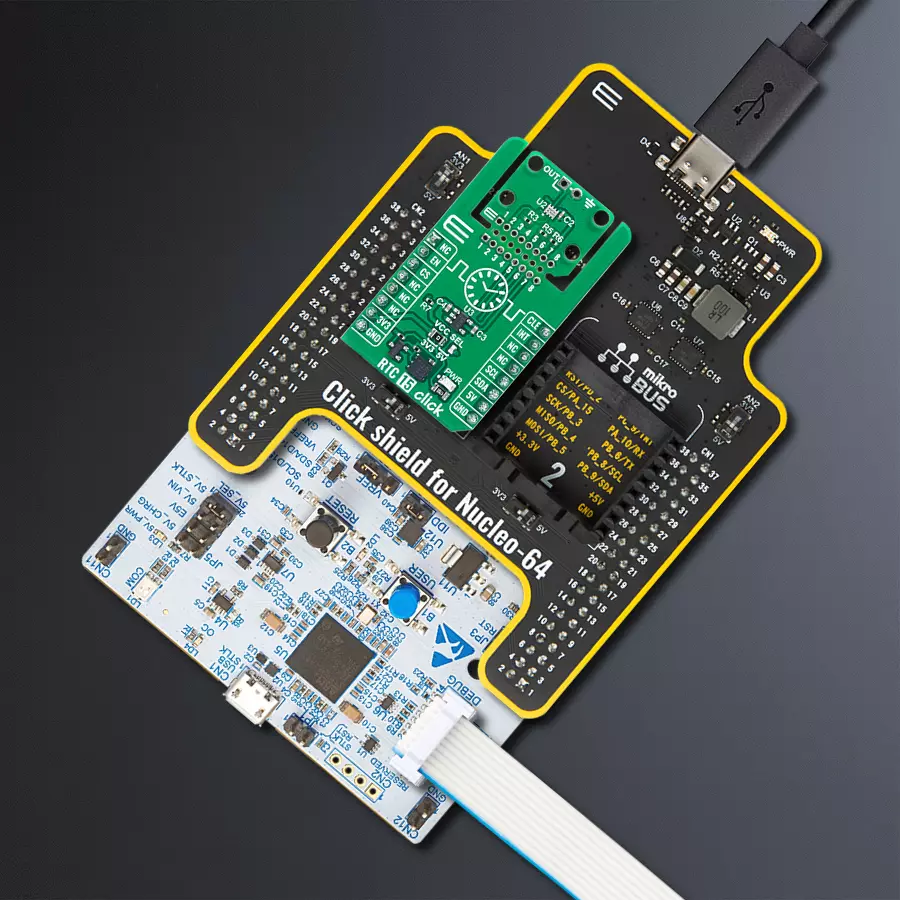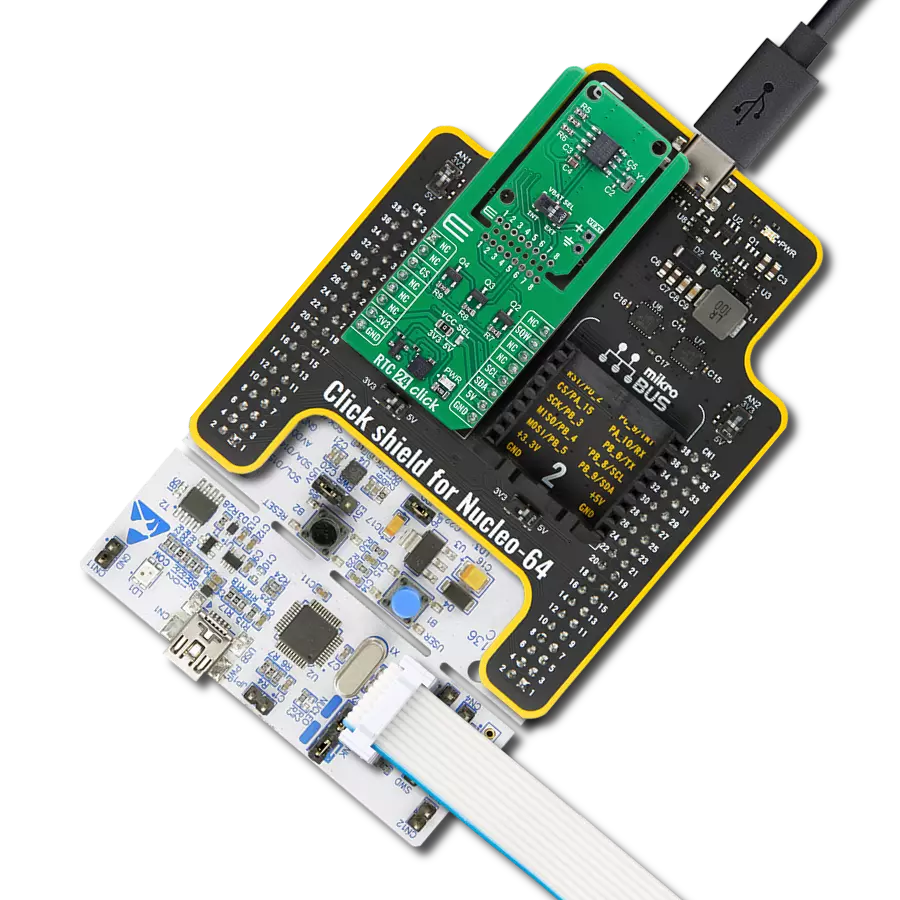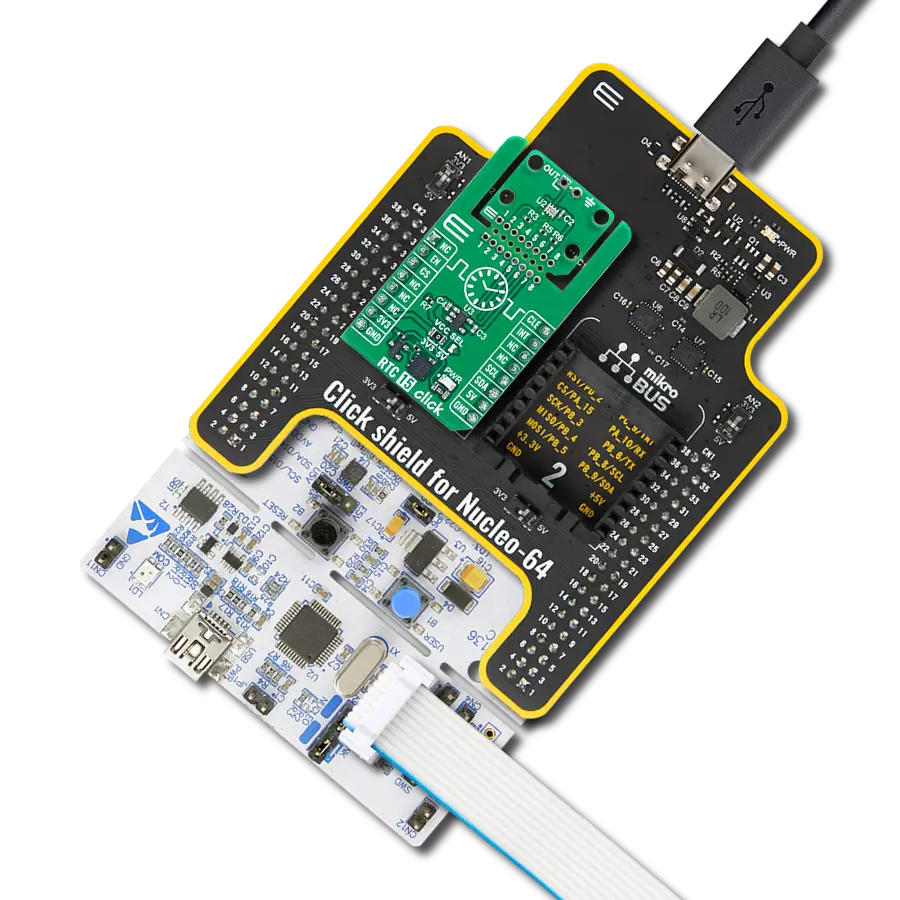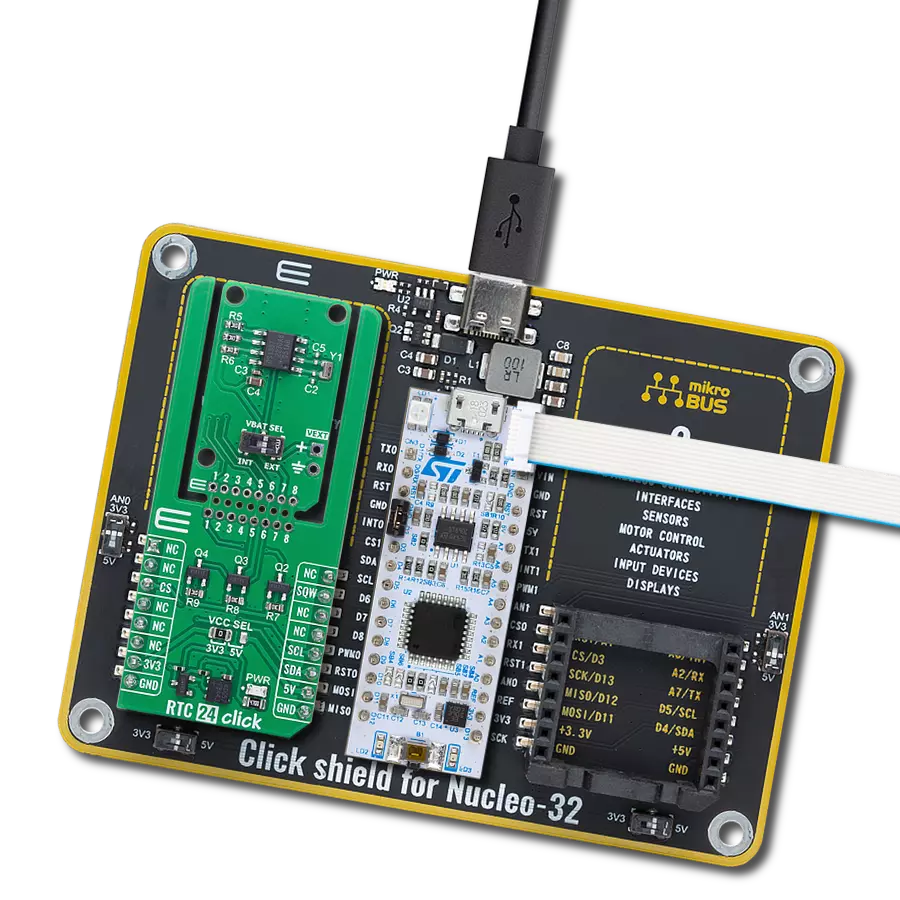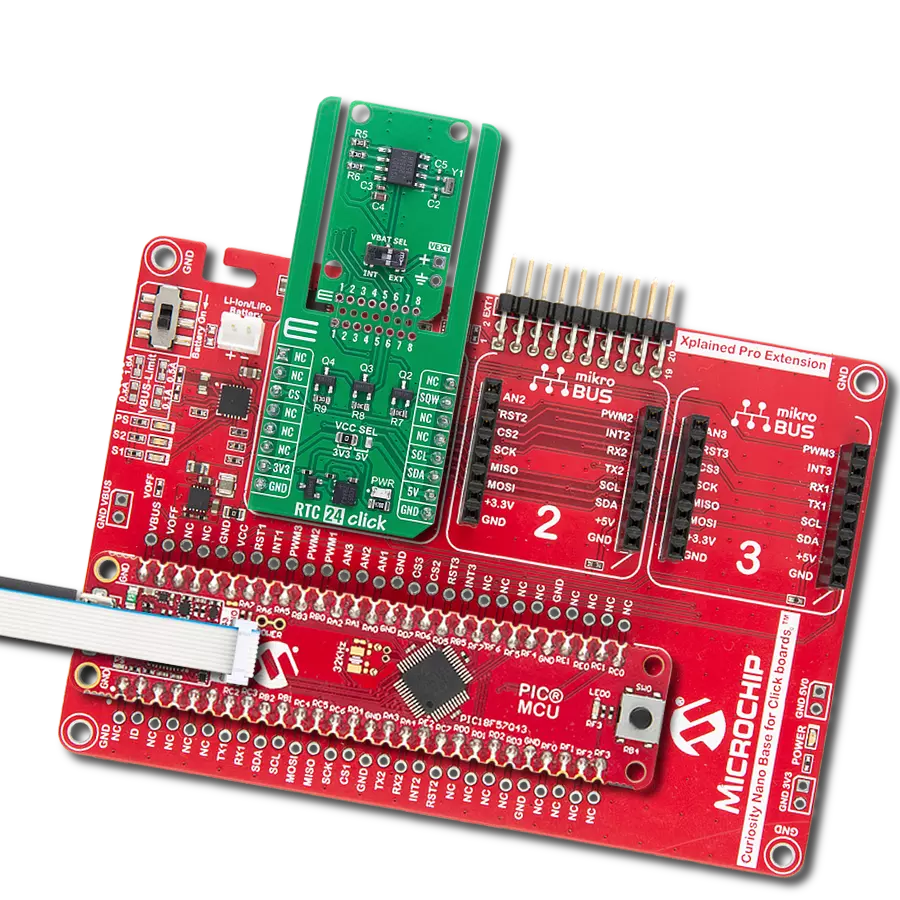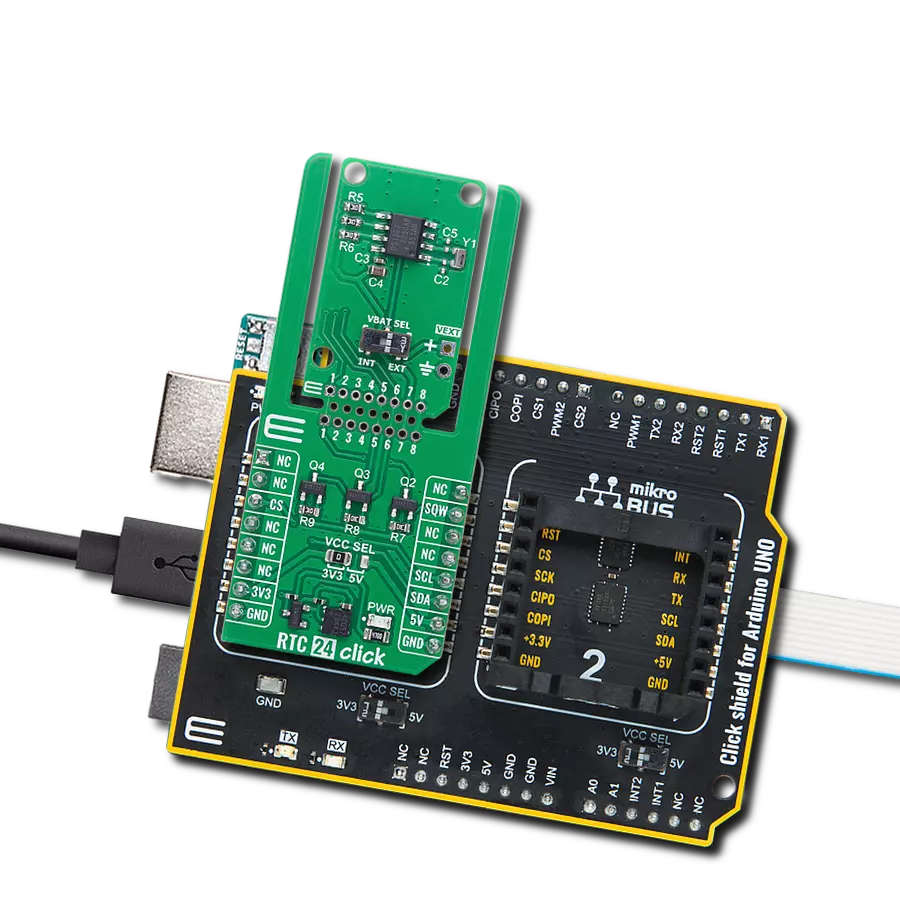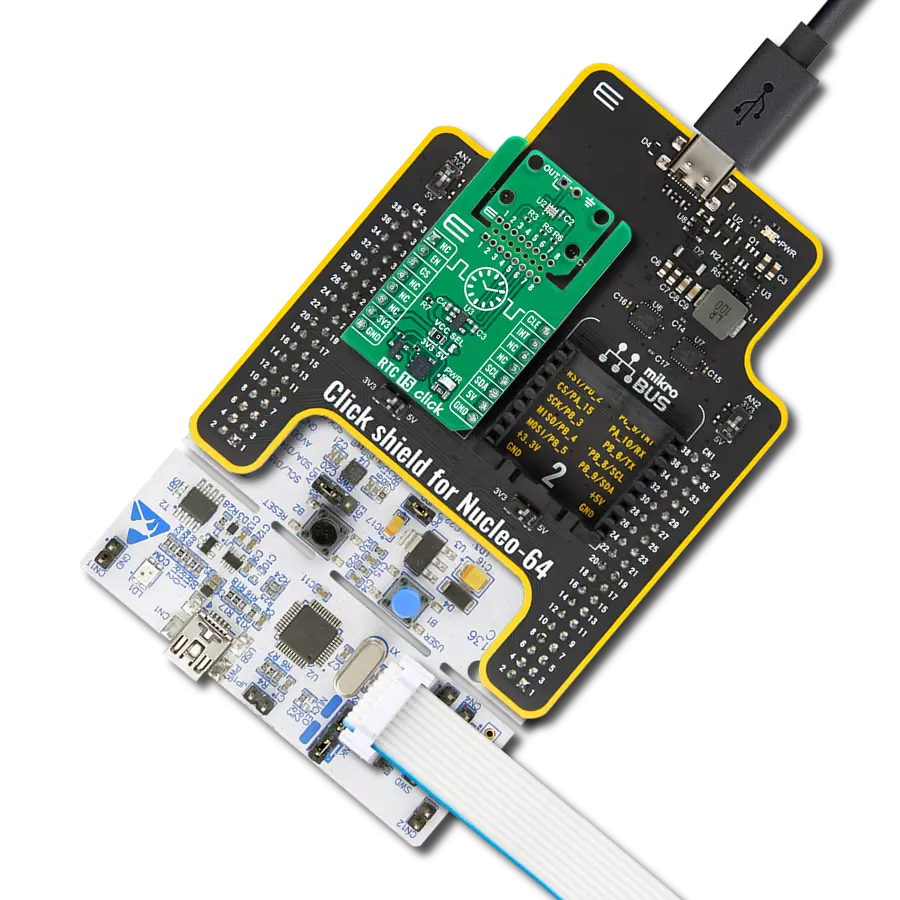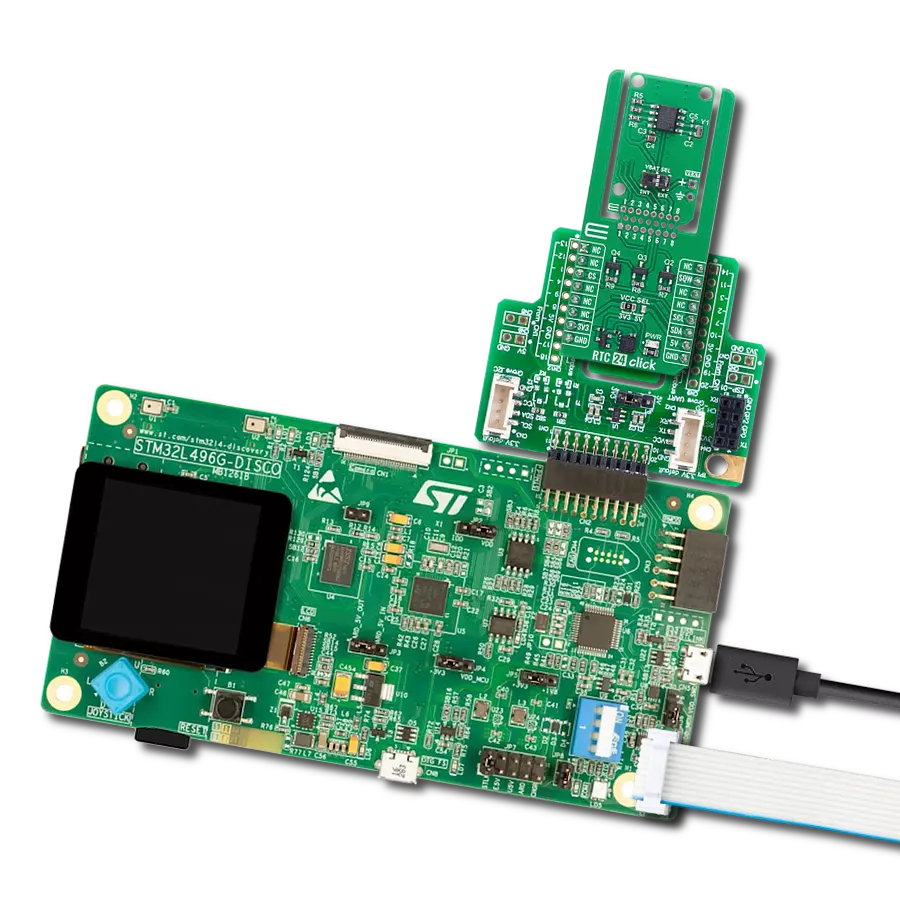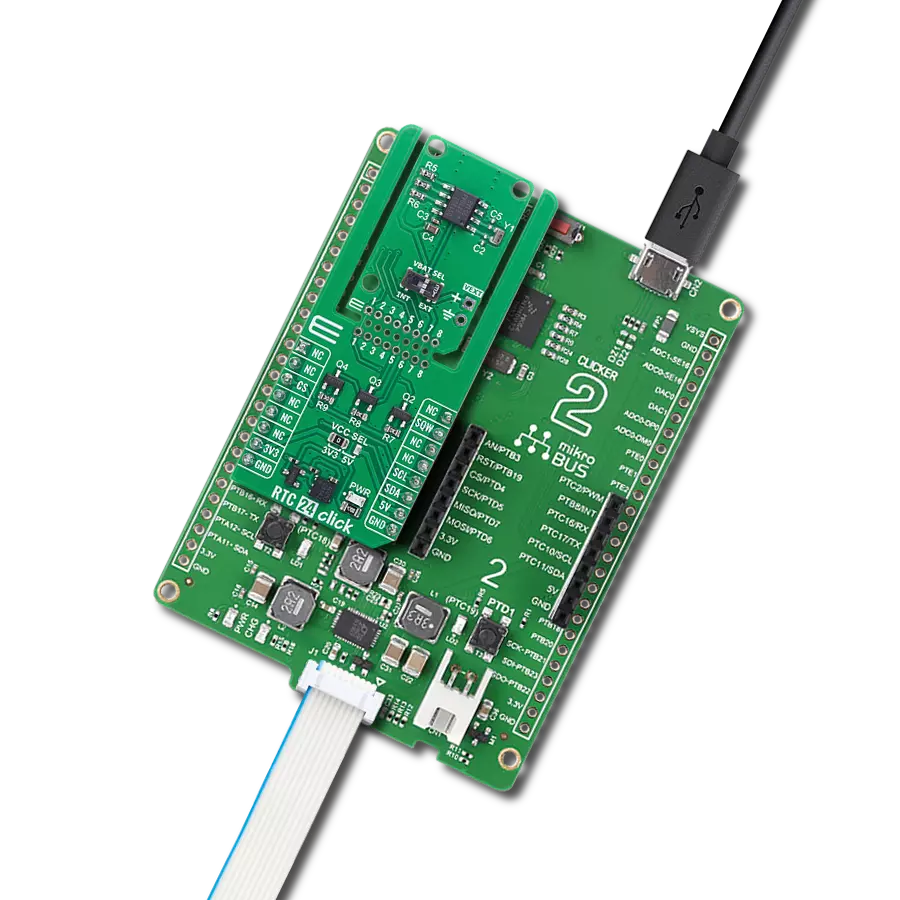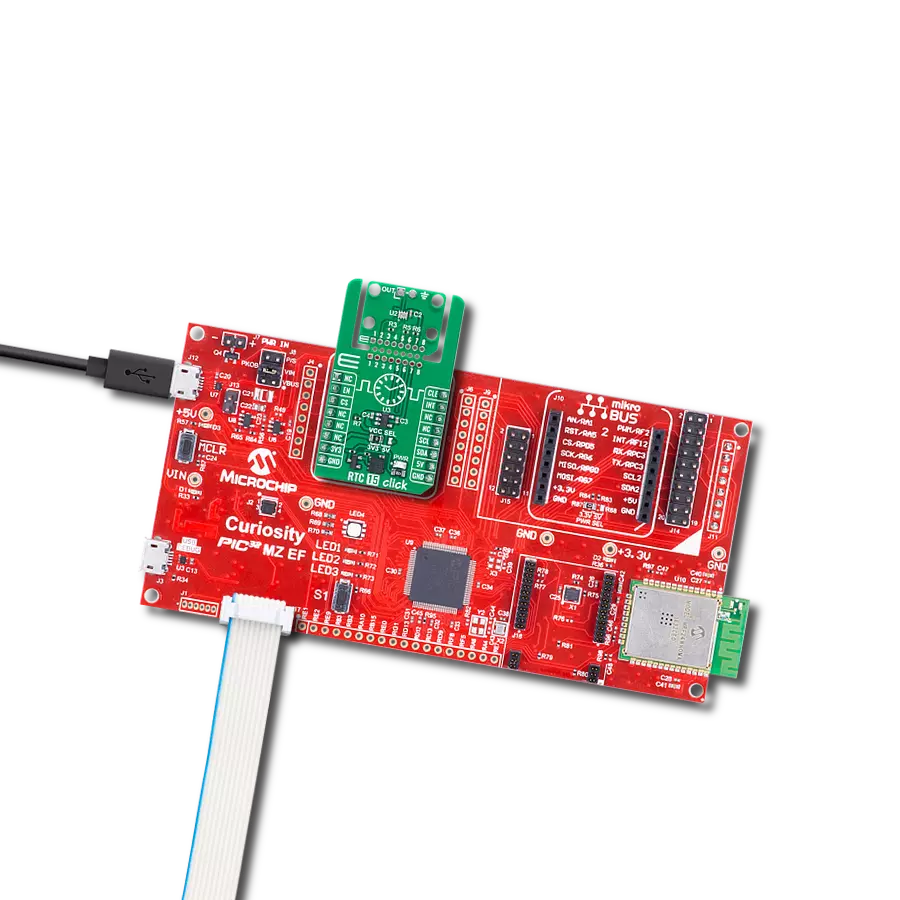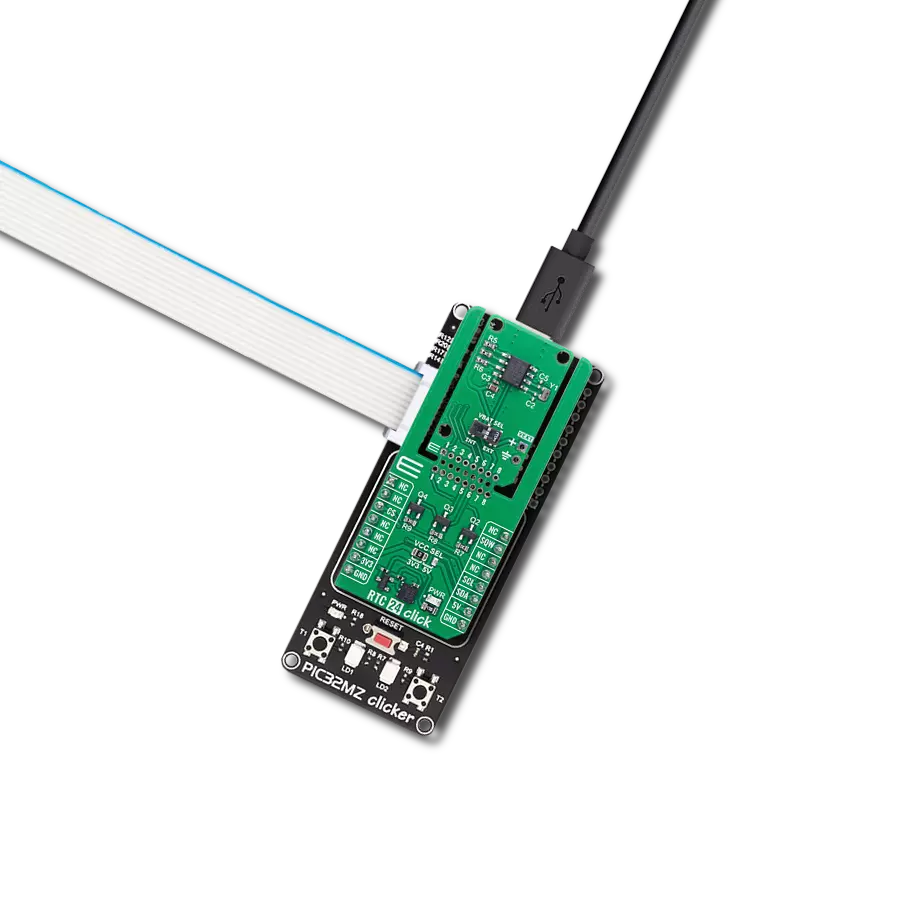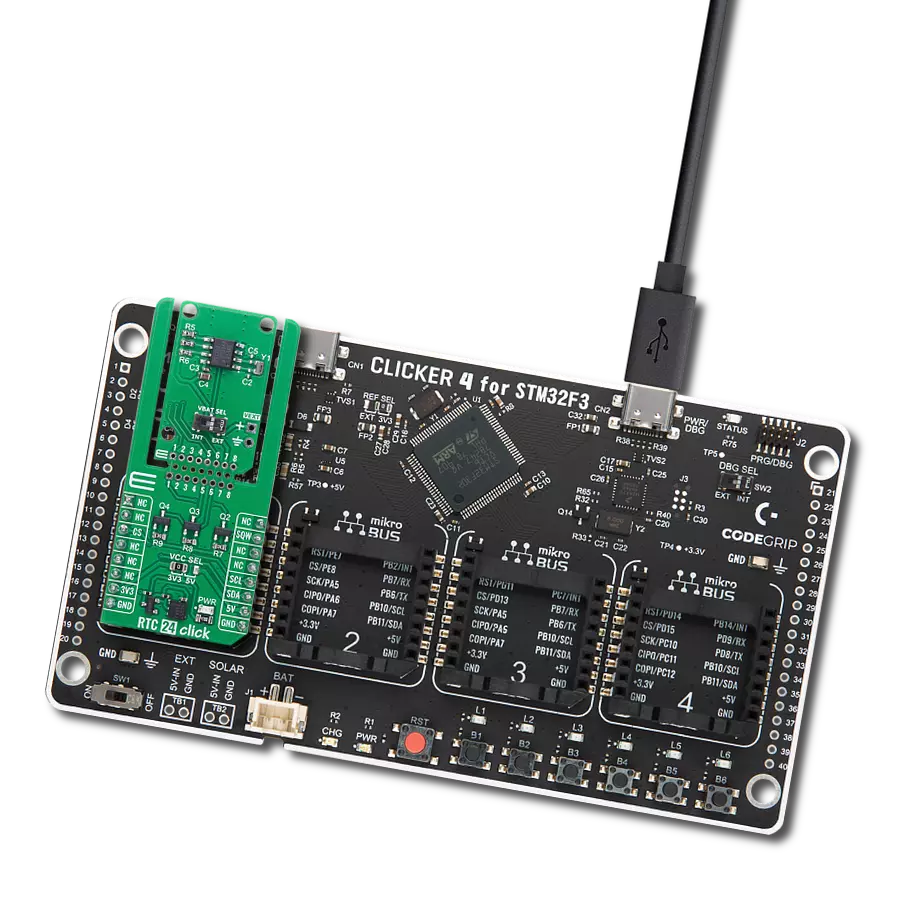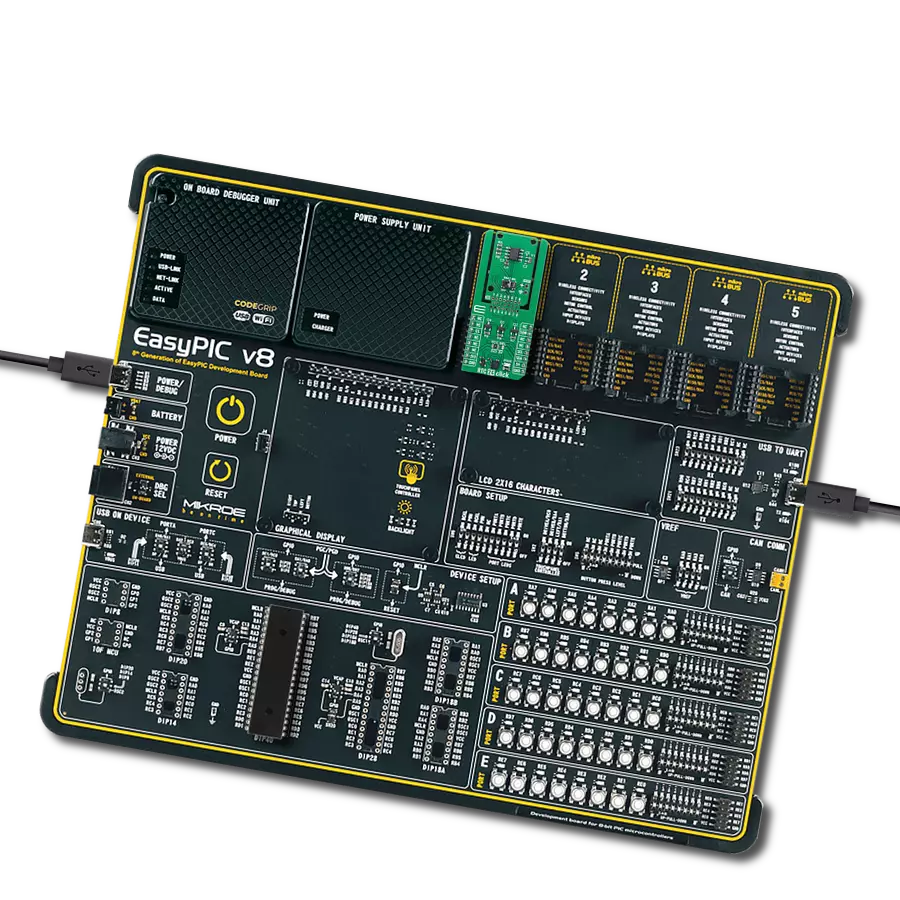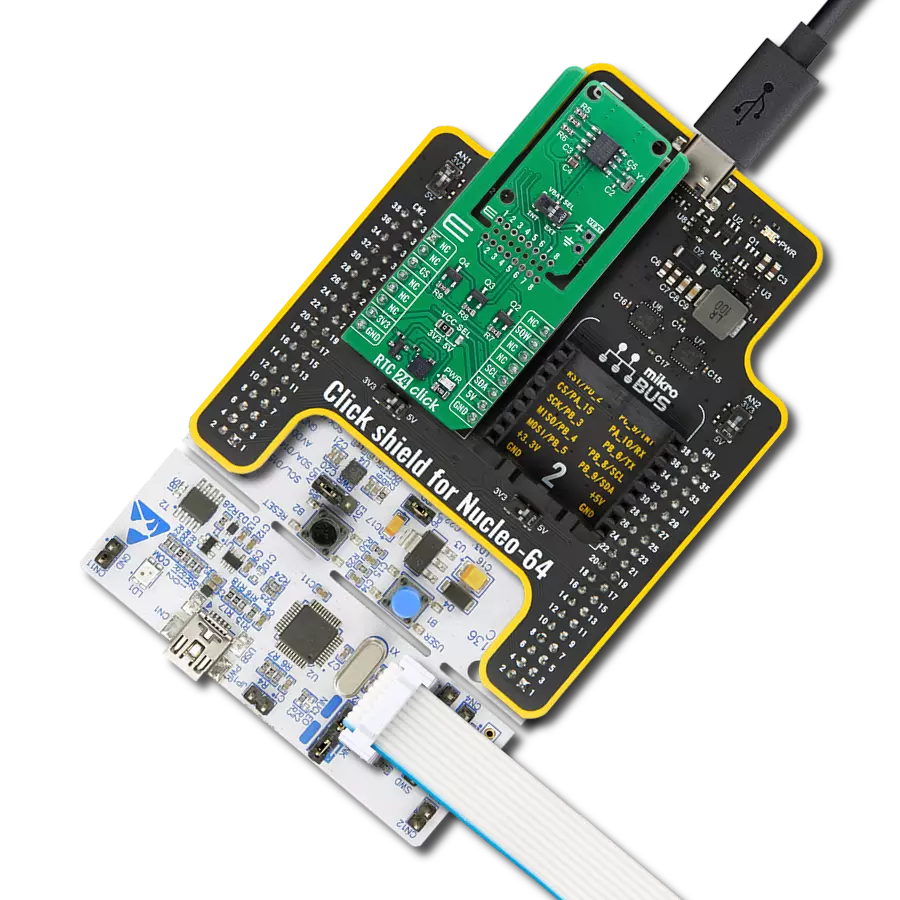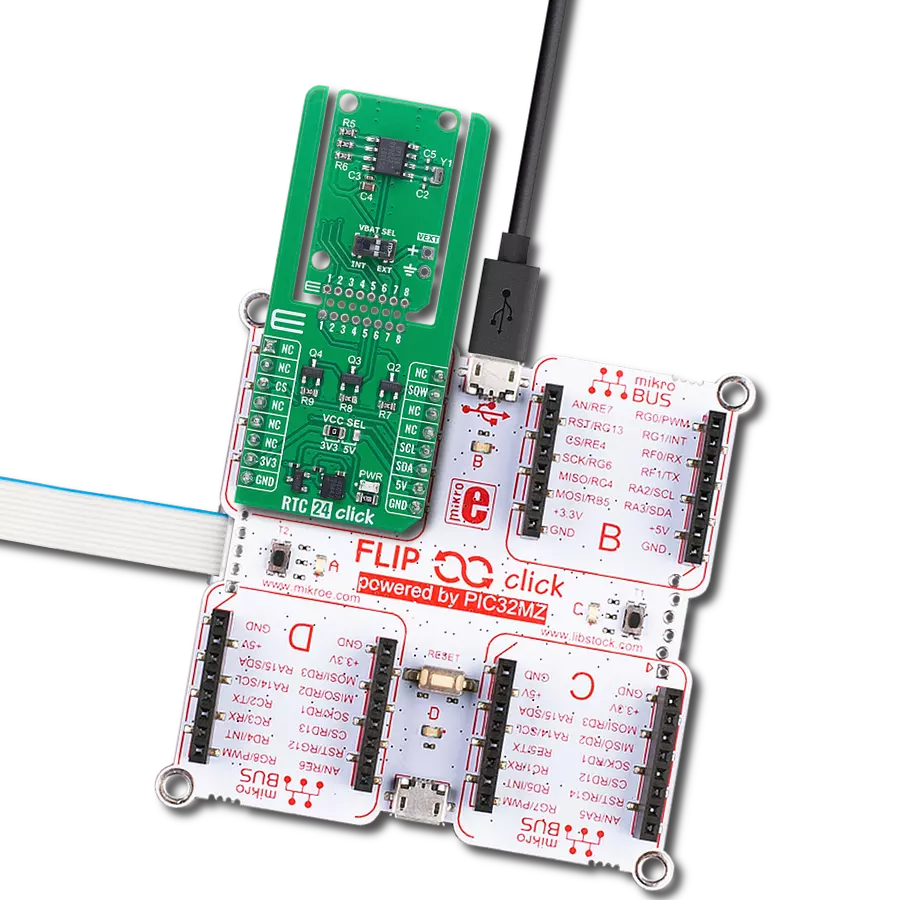Track precise time and date in embedded projects with ultra-low-power RTC module
A
A
Hardware Overview
How does it work?
RTC 15 Click is based on the RV-8263-C8, a standard commercial-grade real-time clock/calendar module from Micro Crystal, known for its low power consumption and high precision. This CMOS-based device operates with a 32.768kHz clock and includes an offset register that enables fine-tuning of frequency deviations, ensuring reliable timekeeping in long-term applications. Communication with the host MCU is handled via an I2C interface, with automatic register address incrementing after each data transfer for efficient access. Despite its ultra-small and lightweight design, the module offers full calendar functionality, including tracking of year, month, date, weekday, hours, minutes, and seconds, along with support for automatic leap year correction from 2000 to 2099. Additionally, it features built-in timer and alarm capabilities. The RTC 15 Click is ideal for use in IoT systems, industrial and automotive applications, metering solutions, healthcare devices, as well as wearable and portable electronics. RTC 15 Click is designed
in a unique format supporting the newly introduced MIKROE feature called "Click Snap." Unlike the standardized version of Click boards, this feature allows the main sensor area to become movable by breaking the PCB, opening up many new possibilities for implementation. Thanks to the Snap feature, the RV-8263-C8 can operate autonomously by accessing their signals directly on the pins marked 1-8. Additionally, the Snap part includes a specified and fixed screw hole position, enabling users to secure the Snap board in their desired location. This Click board™ uses an I2C interface with clock speeds of up to 400kHz, ensuring fast communication with the host MCU. In addition to the I2C interface pins, RTC 15 Click features an EN pin used to control the MAX40200 ideal diode, which in this design acts as a power switch, and INT pin as interrupt used to output alarm, minute, half minute, countdown timer and compensation Interrupt signals. When the EN pin is activated, it enables the MAX40200 to supply power to sensor on the board. This setup allows power management
by enabling or disabling the sensor as needed, making it especially useful for low-power and battery-operated applications. RTC 15 Click also includes unsoldered OUT pins that can be used for clock signal output, controlled by the CLE pin. When the CLE pin is set HIGH, the OUT pin generates a selectable square wave output with available frequencies of 32.768kHz (default), 16.384kHz, 8.192kHz, 4.096kHz, 2.048kHz, 1.024kHz, or 1Hz, offering flexibility for various timing requirements. If the CLE pin is held LOW, the OUT pin remains LOW, effectively disabling the clock output. This Click board™ can operate with either 3.3V or 5V logic voltage levels selected via the VCC SEL jumper. This way, both 3.3V and 5V capable MCUs can use the communication lines properly. Also, this Click board™ comes equipped with a library containing easy-to-use functions and an example code that can be used as a reference for further development.
Features overview
Development board
Nucleo-64 with STM32G474R MCU offers a cost-effective and adaptable platform for developers to explore new ideas and prototype their designs. This board harnesses the versatility of the STM32 microcontroller, enabling users to select the optimal balance of performance and power consumption for their projects. It accommodates the STM32 microcontroller in the LQFP64 package and includes essential components such as a user LED, which doubles as an ARDUINO® signal, alongside user and reset push-buttons, and a 32.768kHz crystal oscillator for precise timing operations. Designed with expansion and flexibility in mind, the Nucleo-64 board features an ARDUINO® Uno V3 expansion connector and ST morpho extension pin
headers, granting complete access to the STM32's I/Os for comprehensive project integration. Power supply options are adaptable, supporting ST-LINK USB VBUS or external power sources, ensuring adaptability in various development environments. The board also has an on-board ST-LINK debugger/programmer with USB re-enumeration capability, simplifying the programming and debugging process. Moreover, the board is designed to simplify advanced development with its external SMPS for efficient Vcore logic supply, support for USB Device full speed or USB SNK/UFP full speed, and built-in cryptographic features, enhancing both the power efficiency and security of projects. Additional connectivity is
provided through dedicated connectors for external SMPS experimentation, a USB connector for the ST-LINK, and a MIPI® debug connector, expanding the possibilities for hardware interfacing and experimentation. Developers will find extensive support through comprehensive free software libraries and examples, courtesy of the STM32Cube MCU Package. This, combined with compatibility with a wide array of Integrated Development Environments (IDEs), including IAR Embedded Workbench®, MDK-ARM, and STM32CubeIDE, ensures a smooth and efficient development experience, allowing users to fully leverage the capabilities of the Nucleo-64 board in their projects.
Microcontroller Overview
MCU Card / MCU
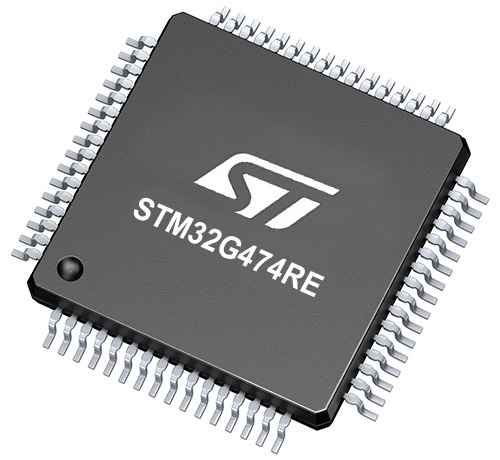
Architecture
ARM Cortex-M4
MCU Memory (KB)
512
Silicon Vendor
STMicroelectronics
Pin count
64
RAM (Bytes)
128k
You complete me!
Accessories
Click Shield for Nucleo-64 comes equipped with two proprietary mikroBUS™ sockets, allowing all the Click board™ devices to be interfaced with the STM32 Nucleo-64 board with no effort. This way, Mikroe allows its users to add any functionality from our ever-growing range of Click boards™, such as WiFi, GSM, GPS, Bluetooth, ZigBee, environmental sensors, LEDs, speech recognition, motor control, movement sensors, and many more. More than 1537 Click boards™, which can be stacked and integrated, are at your disposal. The STM32 Nucleo-64 boards are based on the microcontrollers in 64-pin packages, a 32-bit MCU with an ARM Cortex M4 processor operating at 84MHz, 512Kb Flash, and 96KB SRAM, divided into two regions where the top section represents the ST-Link/V2 debugger and programmer while the bottom section of the board is an actual development board. These boards are controlled and powered conveniently through a USB connection to program and efficiently debug the Nucleo-64 board out of the box, with an additional USB cable connected to the USB mini port on the board. Most of the STM32 microcontroller pins are brought to the IO pins on the left and right edge of the board, which are then connected to two existing mikroBUS™ sockets. This Click Shield also has several switches that perform functions such as selecting the logic levels of analog signals on mikroBUS™ sockets and selecting logic voltage levels of the mikroBUS™ sockets themselves. Besides, the user is offered the possibility of using any Click board™ with the help of existing bidirectional level-shifting voltage translators, regardless of whether the Click board™ operates at a 3.3V or 5V logic voltage level. Once you connect the STM32 Nucleo-64 board with our Click Shield for Nucleo-64, you can access hundreds of Click boards™, working with 3.3V or 5V logic voltage levels.
Used MCU Pins
mikroBUS™ mapper
Take a closer look
Click board™ Schematic
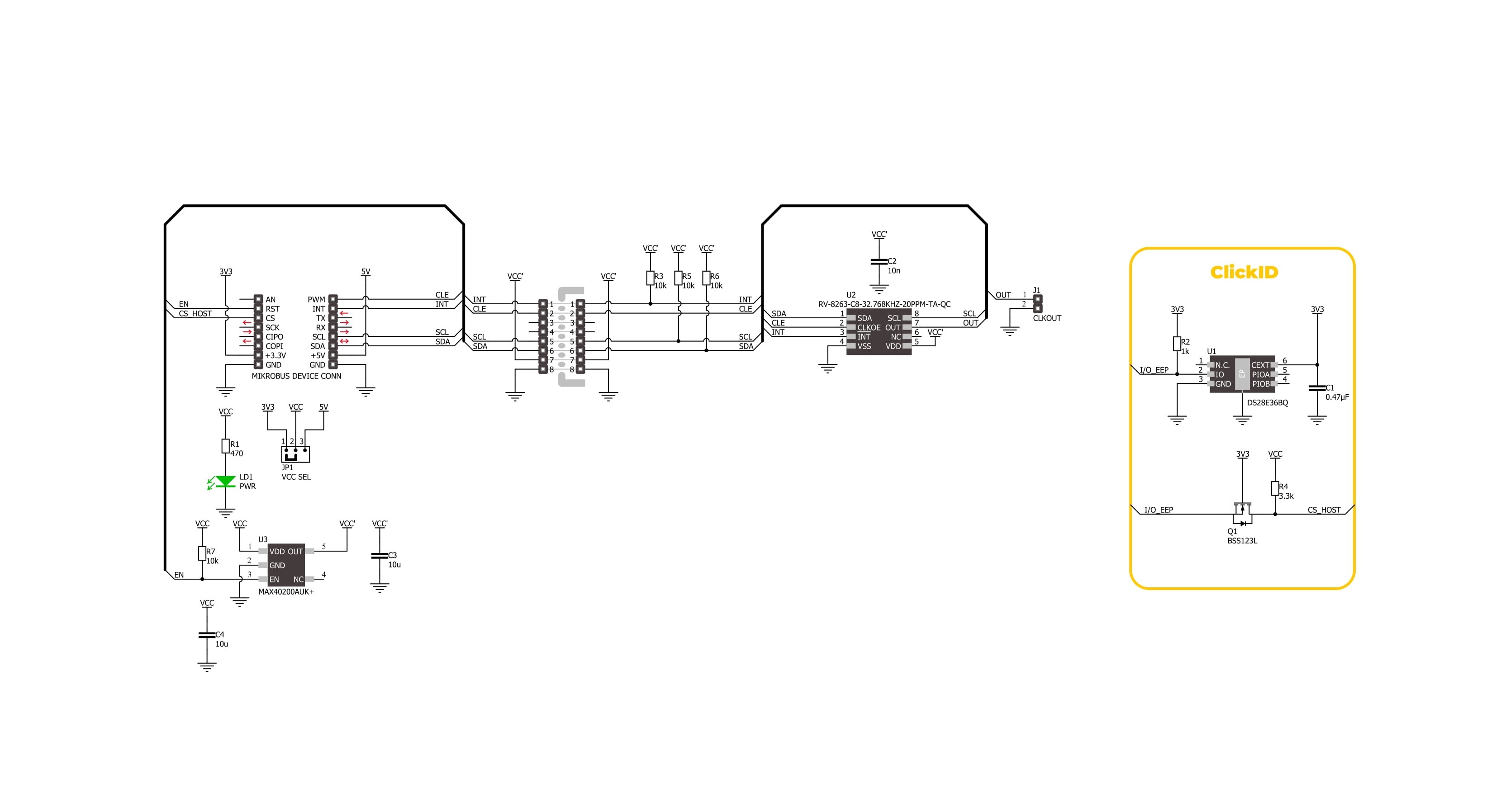
Step by step
Project assembly
Software Support
Library Description
RTC 15 Click demo application is developed using the NECTO Studio, ensuring compatibility with mikroSDK's open-source libraries and tools. Designed for plug-and-play implementation and testing, the demo is fully compatible with all development, starter, and mikromedia boards featuring a mikroBUS™ socket.
Example Description
This example demonstrates the use of the RTC 15 Click board by initializing the device and setting up the current time and date. It continuously reads and displays the updated time and date every second using the timer countdown interrupt pin.
Key functions:
rtc15_cfg_setup- This function initializes Click configuration structure to initial values.rtc15_init- This function initializes all necessary pins and peripherals used for this Click board.rtc15_default_cfg- This function executes a default configuration of RTC 15 Click board.rtc15_set_time- This function sets the current time (hours, minutes, seconds) in the RTC.rtc15_read_time- This function reads the current time (hours, minutes, seconds) from the RTC.rtc15_read_date- This function reads the current date (day, day of week, month, year) from the RTC.
Application Init
Initializes the logger and the RTC 15 Click driver, applies the default configuration, and sets the starting time and date.
Application Task
Waits for a 1 Hz interrupt signal and then reads and displays the current time and date.
Open Source
Code example
The complete application code and a ready-to-use project are available through the NECTO Studio Package Manager for direct installation in the NECTO Studio. The application code can also be found on the MIKROE GitHub account.
/*!
* @file main.c
* @brief RTC 15 Click example
*
* # Description
* This example demonstrates the use of the RTC 15 Click board by initializing
* the device and setting up the current time and date. It continuously
* reads and displays the updated time and date every second using the timer
* countdown interrupt pin.
*
* The demo application is composed of two sections:
*
* ## Application Init
* Initializes the logger and the RTC 15 Click driver, applies the default configuration,
* and sets the starting time and date.
*
* ## Application Task
* Waits for a 1 Hz interrupt signal and then reads and displays the current time and date.
*
* @author Stefan Filipovic
*
*/
#include "board.h"
#include "log.h"
#include "rtc15.h"
static rtc15_t rtc15;
static log_t logger;
static rtc15_time_t time;
static rtc15_date_t date;
/**
* @brief RTC 15 get day of week name function.
* @details This function returns the name of day of the week as a string.
* @param[in] ctx : Click context object.
* See #rtc15_t object definition for detailed explanation.
* @param[in] day_of_week : Day of week decimal value.
* @return Name of day as a string.
* @note None.
*/
static uint8_t *rtc15_get_day_of_week_name ( uint8_t day_of_week );
void application_init ( void )
{
log_cfg_t log_cfg; /**< Logger config object. */
rtc15_cfg_t rtc15_cfg; /**< Click config object. */
/**
* Logger initialization.
* Default baud rate: 115200
* Default log level: LOG_LEVEL_DEBUG
* @note If USB_UART_RX and USB_UART_TX
* are defined as HAL_PIN_NC, you will
* need to define them manually for log to work.
* See @b LOG_MAP_USB_UART macro definition for detailed explanation.
*/
LOG_MAP_USB_UART( log_cfg );
log_init( &logger, &log_cfg );
log_info( &logger, " Application Init " );
// Click initialization.
rtc15_cfg_setup( &rtc15_cfg );
RTC15_MAP_MIKROBUS( rtc15_cfg, MIKROBUS_1 );
if ( I2C_MASTER_ERROR == rtc15_init( &rtc15, &rtc15_cfg ) )
{
log_error( &logger, " Communication init." );
for ( ; ; );
}
if ( RTC15_ERROR == rtc15_default_cfg ( &rtc15 ) )
{
log_error( &logger, " Default configuration." );
for ( ; ; );
}
time.hour = 23;
time.minute = 59;
time.second = 50;
if ( RTC15_OK == rtc15_set_time ( &rtc15, &time ) )
{
log_printf( &logger, " Set time: %.2u:%.2u:%.2u\r\n",
( uint16_t ) time.hour, ( uint16_t ) time.minute, ( uint16_t ) time.second );
}
date.day_of_week = RTC15_TUESDAY;
date.day = 31;
date.month = 12;
date.year = 24;
if ( RTC15_OK == rtc15_set_date ( &rtc15, &date ) )
{
log_printf( &logger, " Set date: %s, %.2u.%.2u.20%.2u.\r\n",
rtc15_get_day_of_week_name ( date.day_of_week ),
( uint16_t ) date.day, ( uint16_t ) date.month, ( uint16_t ) date.year );
}
log_info( &logger, " Application Task " );
}
void application_task ( void )
{
// Wait for a timer countdown flag configured at 1 Hz
while ( rtc15_get_int_pin ( &rtc15 ) );
if ( RTC15_OK == rtc15_read_time ( &rtc15, &time ) )
{
log_printf( &logger, " Time: %.2u:%.2u:%.2u\r\n",
( uint16_t ) time.hour, ( uint16_t ) time.minute, ( uint16_t ) time.second );
}
if ( RTC15_OK == rtc15_read_date ( &rtc15, &date ) )
{
log_printf( &logger, " Date: %s, %.2u.%.2u.20%.2u.\r\n\n",
rtc15_get_day_of_week_name ( date.day_of_week ),
( uint16_t ) date.day, ( uint16_t ) date.month, ( uint16_t ) date.year );
}
Delay_ms ( 100 );
}
int main ( void )
{
/* Do not remove this line or clock might not be set correctly. */
#ifdef PREINIT_SUPPORTED
preinit();
#endif
application_init( );
for ( ; ; )
{
application_task( );
}
return 0;
}
static uint8_t *rtc15_get_day_of_week_name ( uint8_t day_of_week )
{
switch ( day_of_week )
{
case RTC15_MONDAY:
{
return "Monday";
}
case RTC15_TUESDAY:
{
return "Tuesday";
}
case RTC15_WEDNESDAY:
{
return "Wednesday";
}
case RTC15_THURSDAY:
{
return "Thursday";
}
case RTC15_FRIDAY:
{
return "Friday";
}
case RTC15_SATURDAY:
{
return "Saturday";
}
case RTC15_SUNDAY:
{
return "Sunday";
}
default:
{
return "Unknown";
}
}
}
// ------------------------------------------------------------------------ END
Additional Support
Resources
Category:RTC
